Acmadenia alternifolia
Acmadenia alternifolia Cham.
Family: Rutaceae
Common names: Knysna porcelain flower (Eng.); Knysna-duineboegoe (Afr.)
Introduction
A robust, fine-textured, floriferous, aromatic shrublet from the fynbos.
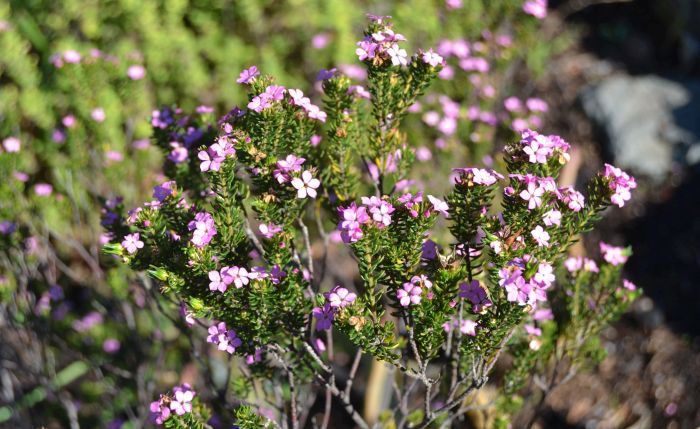
Description
Description
A single-stemmed, much-branched, small shrub of 1 × 1 m. The aromatic leaves are variable, from linear to lanceolate, with tips acute to sharply mucronate. The leaf margins are rough to the touch (scabrid).
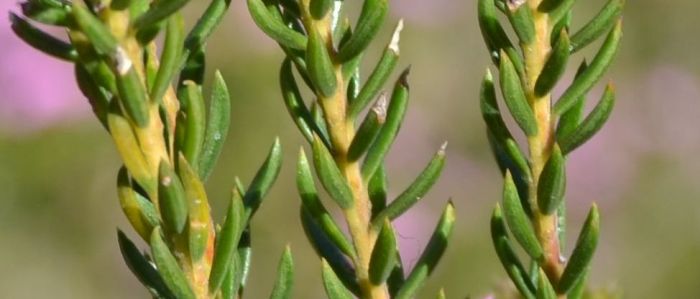
Masses of pink flowers adorn the branch tips from mid- to late winter (June to August). Fruits with long horns.
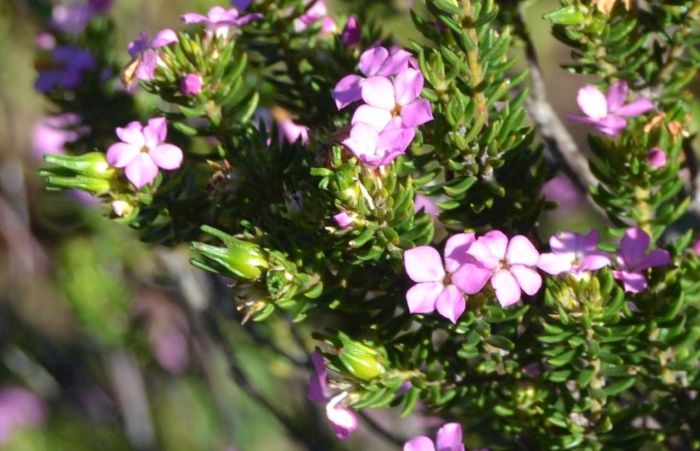
Conservation Status
Status
Acmadenia alternifolia is assessed as Vulnerable (VU) on the Red List of South African plants. This plant species is recorded to occur in 11 locations, 2 of which have been lost, 4 are uncertain and it has been observed in 5 locations. Populations are declining due to loss of habitat caused by housing developments, invasive alien species and too frequent fires. Forestry plantations caused population decline in the past. Most subpopulations are small.
Distribution and habitat
Distribution description
Acmadenia alternifolia occurs naturally in the Cape Floristic Region of South Africa in the Knysna Sand Fynbos vegetation type. It is mainly distributed from Knysna to Plettenberg Bay and extends as far as Nature’s Valley. The area is characterized by coastal headlands, steep slopes and dry coastal cliffs, dominated by species typical of Sandstone Fynbos.
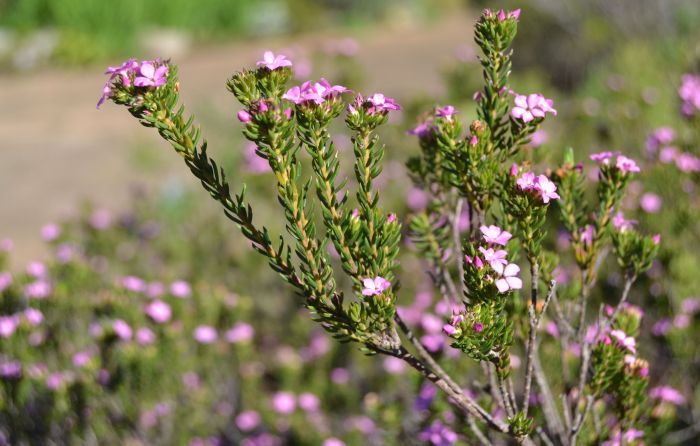
Derivation of name and historical aspects
History
The genus name Acmadenia is derived from the Greek word, akme, meaning ‘highest point’, and aden, meaning ‘a gland’, referring to glands on the anthers. This gives significance to the conical gland at the apex of the anther, which is common in some species in this genus. The species name alternifolia refers to the plant having alternate leaves; the leaves are situated on each side of the stem but not opposite to each other.
The genus consists of 33 species, which occur naturally in the Fynbos Biome. Acmadenia belongs to the citrus family (Rutaceae) and the leaves of the plants are freckled with aromatic oil glands that produce fragrances unique to each species.
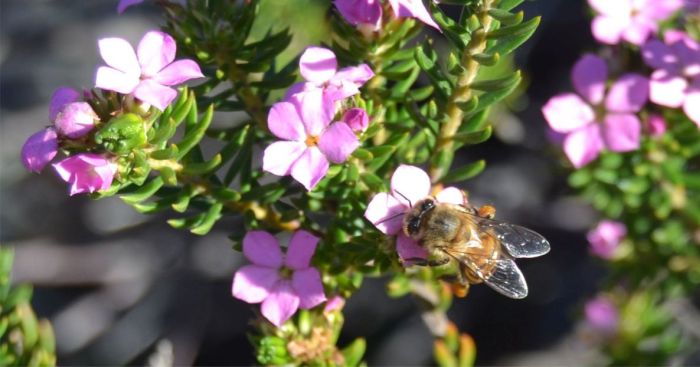
Ecology
Ecology
This species is mainly pollinated by bees.
Uses
Use
No medicinal or cultural uses have been recorded, but this species would be a wonderful addition to any garden.
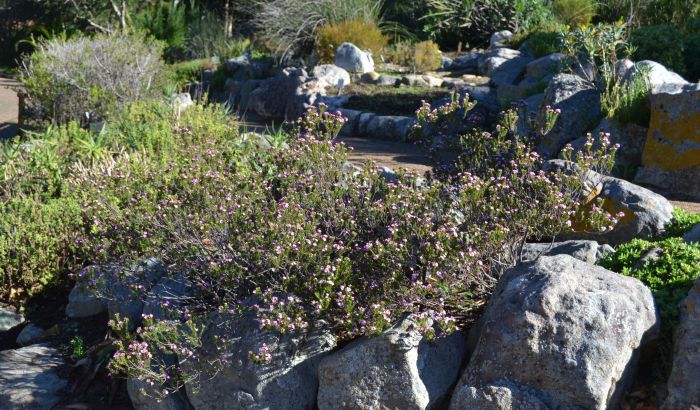
Growing Acmadenia alternifolia
Grow
To date, no records are known to the authors of this species being grown from seed. However, given that this is a fynbos species, and that the biome is, by and large, driven by fire, a starting point to consider when attempting seed propagation, would be the use of smoke or smoke-related products. Soak the seed in smoke-infused water and sow in autumn, using any light and well-draining medium. Cover the small seeds with a thin layer of sand or fine-milled bark and then water. Sufficient light and ventilation of the space where you house the sowing-tray are crucial. Do not overwater or allow the tray to totally dry out. Although the time to germination for this species is unknown, expect germination from the third week. The appearance of the first true leaves signifies that potting can commence.
At Kirstenbosch, this species is propagated vegetatively by cuttings taken in autumn, although trials in other seasons can also be considered. Take cuttings of between 25 and 55 mm length, from the current year’s new growth. Remove roughly a third of the foliage, cut below the node and dip in a rooting hormone. The rooting medium is a 50 % mixture of bark and perlite, but this can vary according to what is available. The cuttings are placed on a heated bench under a mist-unit. Rooted cuttings are shifted to a hardening-off section for about 2 weeks after which potting can commence.
Potted plants are placed in a shady section for 2 weeks up to a month and then moved to full sun. This is a good time to pinch out the growing tips of the seedlings, or to prune plants grown from cuttings, to facilitate a more bushy growth habit.
Acmadenia alternifolia thrives in full sun and well-drained soil. Autumn and winter, which is the rainy season in the Fynbos Biome, is the preferred planting time. Planting with the rain ensures that plants have a good chance of establishing themselves in the garden before the onslaught of the dry, heat of summer. Generally, with buchus, maintaining planting intervals of 200–300 mm is deemed adequate as it provides ample space to encourage growth. Such dense planting help plants to better cope with dry spells by retaining soil moisture. Provide a good thorough watering in autumn and winter once planted, and continue watering regularly if the rainy season is not yet in full swing. Irrigation during the late spring to summer should be kept to a minimum, however, care must be taken not to allow plants to dry out totally. A generous layer of well-sterilized mulch will also go a long way in ensuring soil moisture is being retained.
This buchu is best suited to fynbos and coastal gardens. Plant it with other fynbos plants such as: Pelargonium cucullatum, P. suburbanum, P. betulinum and P. capitatum, Passerina corymbosa and P. intermedia, Coleonema album and C. pulchellum, Agathosma serpyllacea, A. apiculata and A. ovata, Salvia aurea, Leonotis ocymifolia and L. leonurus, Metalasia muricata and M. densa, Helichrysum felinum, Leucospermum cuneiforme, Leucadendron salignum and L. eucalyptifolium, Protea cynaroides, Thamnochortus cinereus, Geranium incanum, Seriphium plumosum, Anthospermum aethiopicum, Berzelia intermedia, Erica diaphana and E. glandulosa subsp fourcadei.
References
- Gould, M. 1992. The buchus: cultivation and propagation. National Botanical Institute, Cape Town.
- Jodamus, N. 2012. Acmadenia mundiana Eckl. & Zeyh. (Rutaceae). PlantzAfrica. Online. https://pza.sanbi.org/Acmadenia-mundiana
- Manning, J. & Goldblatt, P. 2012. Plants of the Greater Cape Floristic Region 1: the Core Cape Flora. Strelitzia 29. South African National Biodiversity Institute, Pretoria.
- Oliver, R. 2011. Agathosma imbricata (L.) Willd. (Rutaceae). PlantzAfrica. Online. https://pza.sanbi.org/Agathosma imbricata.
- Raimondo, D., Victor, J.G & Hutchinson, S.L. 2012. Acmadenia alternifolia Cham. National Assessment: Red List of South African plants version 2020.1. Assessed on 2021/05/25
- Rebelo, A.G., Boucher, C., Helme, N., Mucina, L. & Rutherford, M. 2006. Fynbos Biome. Strelitzia 19. South African National Biodiversity Institute, Pretoria.
- Stearn, W. 2002. Stearn's dictionary of plant names for gardeners. Timber Press, Portland, Oregon.
Credits
Roger Oliver & Nosipho Ndlovu
Kirstenbosch National Botanical Garden
July 2021
Plant Attributes:
Plant Type: Shrub
SA Distribution: Western Cape
Soil type: Sandy, Loam
Flowering season: Spring, Winter
PH: Acid
Flower colour: Pink
Aspect: Full Sun
Gardening skill: Easy
Special Features:
Horticultural zones








Rate this article
Article well written and informative
Rate this plant
Is this an interesting plant?
Login to add your Comment
Back to topNot registered yet? Click here to register.